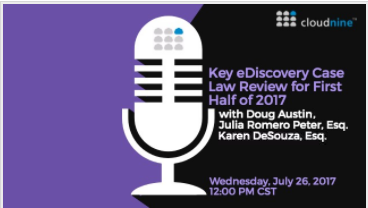Defendant Not Sanctioned Despite Use of Evidence Wiping Software: eDiscovery Case Week
eDiscovery Case Week continues. We’ll cover four cases this week (catching up on a couple from earlier this year) and we’ll cover our Wednesday webcast Key eDiscovery Case Law Review for First Half of 2017 (click here to sign up for that) as well. Here’s the next case. And, unlike the “Phelps vs. Shark” debacle, I promise nothing about this post was computer generated… :o)
In HCC Ins. Holdings, Inc. v. Flowers, No. 1:15-cv-3262-WSD (N.D. Ga., Jan. 30, 2017), Georgia District Judge William S. Duffey, Jr. denied the plaintiff’s motion for adverse inference sanctions despite evidence that the defendant had used evidence wiping software twice after being ordered to produce her personal computer, stating that the plaintiff “offers only bare speculation that any of its trade secrets or other data were actually transferred” to the defendant’s laptop.
Case Background
In this case, the defendant was accused of misappropriating trade secrets after she left her company and started a competitive company. The plaintiff claimed that when the defendant left the company, she took confidential files with her to benefit her new company and also claimed that, after receiving the lawsuit papers in this case, and after the Court ordered the defendant to produce her personal computer, she destroyed data on her personal laptop and also on a thumb drive that was plugged into her personal computer on September 20, 2015 (which was after she received a preservation notice and the complaint in the case).
The defendant’s husband, an experienced IT professional, claimed he inserted his personal thumb drive on September 20 to back-up data on the defendant’s personal laptop, but the thumb drive was corrupted and did not work, and that he therefore threw it away (the defendant’s own computer forensic expert claimed that it did work properly the second time, when it was plugged in for 38 seconds.
On September 19, 2015, and again three days later, the day after the Court ordered the defendant to produce her personal computer, the computer wiping program CCleaner was manually run on her personal laptop. During that time, the program Defraggler (program that overwrites deleted files in unallocated space on a computer’s hard drive) was also run and so was a program called WinUndelete (which is used to recover deleted files). The plaintiff claimed the defendant’s husband used WinUndelete to confirm that he had destroyed evidence, but he claimed he ran the program off of his work thumb drive to familiarize himself with it for future use for work purposes. After running extensive searches over several weeks, a neutral examiner did not locate any of the plaintiff’s confidential information or trade secrets on any of the devices produced by the defendant.
Judge’s Ruling
In reviewing the results, Judge Duffey stated: “HCC’s Motion is based on a series of events it casts as suspicious, but HCC offers only bare speculation that any of its trade secrets or other data were actually transferred from HCC Life’s systems to Flowers’ personal laptop. A party seeking spoliation sanctions must prove that (1) the missing evidence existed at one time; (2) the defendant had a duty to preserve the evidence; and (3) the evidence was crucial to the plaintiff’s prima facie case… Here, after extensive discovery, including examinations by a neutral forensic examiner and the parties’ expert forensic examiners, depositions, and subpoenas of email and cloud-based storage companies, HCC does not provide any evidence to show that Flowers or her husband actually transferred any data from HCC Life to her personal devices or cloud storage media she controlled.”
As a result, Judge Duffey ruled as follows: “Though Flowers’ and her husband’s actions are troubling, and in breach of her duty to preserve, the Court finds spoliation sanctions are not warranted.”
So, what do you think? Is this ruling troubling? Or should the motioning party be required to show evidence of actual responsive ESI deleted? Please share any comments you might have or if you’d like to know more about a particular topic.

Case opinion link courtesy of eDiscovery Assistant.
Disclaimer: The views represented herein are exclusively the views of the author, and do not necessarily represent the views held by CloudNine. eDiscovery Daily is made available by CloudNine solely for educational purposes to provide general information about general eDiscovery principles and not to provide specific legal advice applicable to any particular circumstance. eDiscovery Daily should not be used as a substitute for competent legal advice from a lawyer you have retained and who has agreed to represent you.





